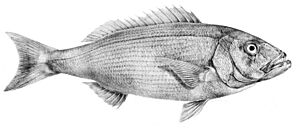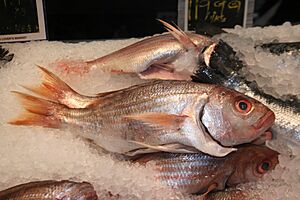Argyrozona facts for kids
Quick facts for kids Argyrozona |
|
|---|---|
 |
|
| Conservation status | |
| Scientific classification | |
| Synonyms | |
|
The carpenter seabream, also known as the doppie, is a type of fish that lives in the ocean. Its scientific name is Argyrozona argyrozona. It's the only species in its group, called Argyrozona. This fish belongs to the Sparidae family, which includes seabreams and porgies. You can only find the carpenter seabream in the waters near southern South Africa.
Contents
How Scientists Classify This Fish
Scientists use a system called taxonomy to group living things. This helps us understand how different species are related.
The Argyrozona Group
The group Argyrozona was first named in 1938. This was done by a South African fish expert named James Leonard Brierley Smith. At that time, it was the only species in this group.
Naming the Carpenter Seabream
The carpenter seabream itself was first officially described in 1830. A French zoologist named Achille Valenciennes gave it the name Dentex argyrozona. He found it near the Cape of Good Hope in South Africa. Today, this fish is part of the Sparidae family. This family is in a larger group called Spariformes.
What Its Name Means
The name Argyrozona is a tautonym. This means it's a scientific name where the group name and the species name are the same. It comes from Dentex argyrozona.
The "Silver Band" Fish
The word argyrozona means "silver band." J. L. B. Smith explained why. He said that after the fish dies, you can see 5 or 6 white stripes on its body. These stripes have beautiful gold and silver colors.
What the Carpenter Seabream Looks Like

The carpenter seabream has a body shaped like a torpedo. Its body is a little less deep than its head is long. The top of its head is smooth. Its lower jaw sticks out a bit. The back part of its upper jaw is not covered by other bones. The two back nostrils are almost perfectly round.
Fins and Colors
The fin on its back, called the dorsal fin, has 12 stiff spines and 10 or 11 soft rays. The fin on its belly, called the anal fin, has 3 spines and 8 soft rays. The fish's body is mostly silver with hints of red. Its lower body is paler. It has several red horizontal lines along its sides. Silver lines appear between these red ones soon after the fish dies. Its fins are pink, and its eyes are orange-red.
Size of the Fish
The biggest carpenter seabream ever recorded was about 90 centimeters (about 3 feet) long. However, most of these fish are usually around 60 centimeters (about 2 feet) long.
Where the Fish Lives
The carpenter seabream lives in the western part of the Indian Ocean. It is only found in the waters off South Africa. You can find it between Table Bay and the mouth of the Kei River. It is not very common further north, like in KwaZulu-Natal.
Its Home in the Ocean
Adult carpenter seabreams live in deeper waters. They prefer depths between 50 and 200 meters (about 164 to 656 feet). They like areas with rough reefs. Younger fish live in shallower water. As they grow up, they move to deeper waters further from the coast.
Life and Habits of the Fish
Most adult carpenter seabreams tend to stay in one area. However, some fish have been tracked moving more than 100 kilometers (about 62 miles).
What They Eat
Adult carpenter seabreams mainly eat squid, anchovies, and sardines. Younger fish have a different diet. They feed on crabs, tiny crab larvae, small shrimp-like creatures called amphipods, and polychaetes (a type of worm).
Reproduction and Young Fish
Carpenter seabreams are gonochorists. This means each fish is either male or female. They spawn in groups, releasing their eggs in batches. Spawning happens in the southern Spring season. Their eggs and larvae float freely in the water. Young fish gather in special "nursery" areas closer to the shore. These nurseries have been found in Algoa Bay and on the central Agulhas Bank.
Fishing and Protecting the Species
The carpenter seabream is an important fish for commercial fishing. Fishermen catch it using long lines and trawling nets.
Protecting the Population
Between 1986 and 2001, studies showed that too many of these fish were being caught. This is called overfishing. After 2003, commercial fishing efforts were reduced. This helped the fish population start to recover. Even with this recovery, the IUCN (International Union for Conservation of Nature) still lists the carpenter seabream as "Near Threatened." This means its population depends on continued efforts to protect it.


